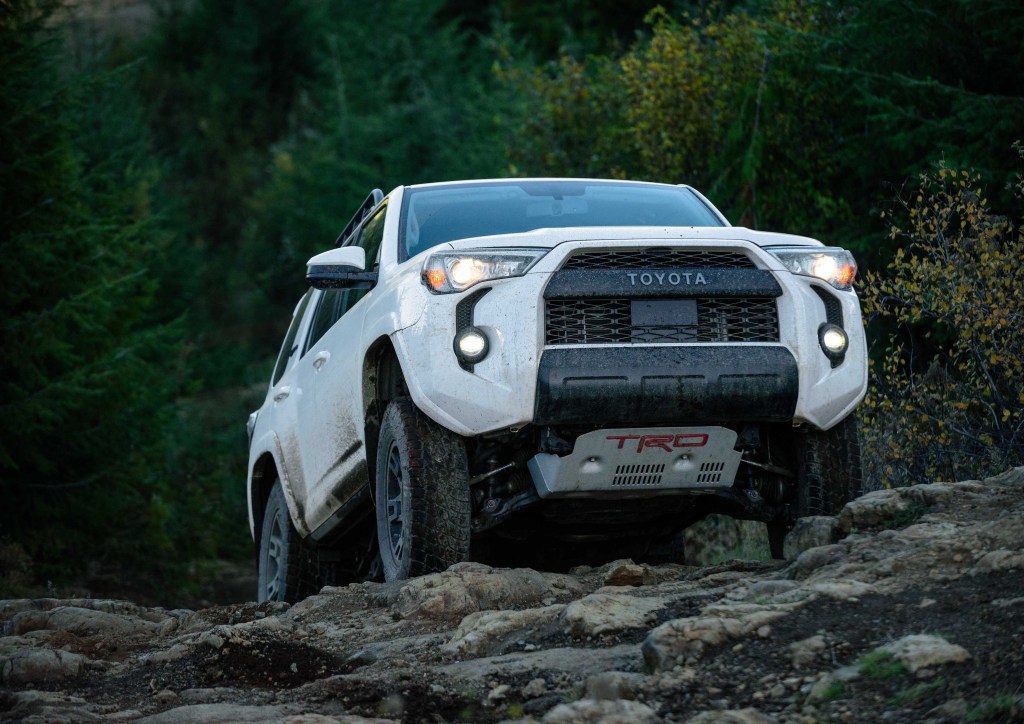
Is a Used Toyota 4Runner as Good as a Brand-New One?
When it comes to daily-drivable off-road SUVs, it’s tough to beat the Toyota 4Runner. True, the SUV’s design is old-school, and it was missing certain safety features until recently. But its design also means it’s practically bulletproof; that and its very-real capability means the Toyota 4Runner holds its value extremely well. Only the Jeep Wrangler depreciates less, but it’s arguably less safe. But the best off-road 4Runner, the TRD Pro, starts at almost $50,000. Used 4Runners can be found for significantly less. But can a used Toyota 4Runner really keep up with a brand-new TRD Pro?
How the used Toyota 4Runner compares to the new TRD Pro model

Canadian YouTubers Throttle House wanted to find out how good the new 4Runner TRD Pro was, and how a used 4Runner performed in comparison. So, the team bought a 2007 4Runner Limited to find out.
Throttle House paid roughly $5,165 for the ’07 SUV, which had about 155,000 miles on the clock. As a Limited model, the used 4Runner came with leather seats (heated up front), adjustable air suspension, and Toyota’s X-REAS system. This consisted of linked hydraulic dampers, which prevented the SUV from rolling too much through corners. This particular used Toyota 4Runner has a 4.7-liter V8, making 260 hp and 306 lb-ft. It’s not a particularly light SUV, weighing 5700 pounds, but it can also tow 7000 pounds.
Like the old 4Runner, the new 4Runner TRD Pro is body-on-frame. However, the new SUV swaps out the air suspension for Fox shocks. These are great for off-roading, and while they make the new 4Runner lean a bit more on-road, the ride is slightly comfier. The new 4Runner also has updated infotainment, with navigation, Apple CarPlay, and Android Auto. However, in the model Throttle House tested, it appeared to be suffering some serious glitches. And the front seats aren’t heated.

While the 2007 4Runner could be equipped with a V6, the new 4Runner lineup is V6-only. The 4.0-liter engine develops 270 hp and 278 lb-ft. Not too far off the old V8, although Throttle House had to rev the V6 higher to accelerate like the V8-equipped SUV. That might explain why the new SUV isn’t any more fuel-efficient than the old one. And because the new 4Runner weighs 600 pounds more, it can’t tow as much: only 5000 pounds.
Is the used Toyota 4Runner just as good off-road?
After driving the SUVs back-to-back on the road, Throttle House moved to some nearby off-road trails. The route featured mud, rocks, dirt, as well as partially-frozen puddles and ice patches.
Both the new and used Toyota 4Runners were more than able to hold their own on the trail. Both come with four-wheel drive, but the TRD Pro’s is part-time, while the used 4Runner’s is always on. But, the TRD Pro features locking center and rear differentials; the ’07 model only has a locking center one.
Both SUVs have skid plates, and hill-descent control, although the used 4Runner’s seemed to be broken. However, the new TRD Pro has a slight edge when it comes to driving modes. Motor Trend reported the Rock mode worked excellently in Moab. The system also has Mud, Sand, and Mogul modes.
But the used 4Runner didn’t really need selectable driving modes. The hosts simply put it in 4Lo and set off. At no point did either 4Runner get stuck. In fact, both the new and old 4Runners managed to easily cross a deep partially-frozen stretch of water that briefly flummoxed the camera-holding Wrangler.
So, if you can’t afford a new TRD Pro, a used Toyota 4Runner is more than capable of keeping up off-road.
Buying a used 4Runner
Although the Toyota 4Runner is remarkably reliable, the SUV does have its share of long-term issues. Most of these are found on 2003-2005 models, with the 2003 model year being the worst. The biggest issue is excessive rust, which Toyota struggled with on other models, as well. The ’03-’05 4Runner’s front brakes have also been known to seize; even replacing the front calipers completely doesn’t always fix the problem.
Interestingly, although Throttle House call the 2007 4Runner’s V8 reliable, this engine has been known to suffer exhaust manifold leaks. The manifold can crack, causing a sulfurous odor and damaging the catalytic converter. However, it may be possible the likeliness of this problem has been overstated. Users on the r/Cars sub-Reddit had many positive comments on the longevity of V8 4Runners.
The 2003-2006 4Runners also had issues with the V6’s head gaskets failing. However, this issue appeared to have been solved by the 2007 model year.
A used Toyota 4Runner does have a benefit over a new one besides cost. 2015 and earlier models, like the Tundra pickup, could be outfitted with a 50-state-legal TRD supercharger, according to Top Speed. You could get one with the money you save by buying used.
Follow more updates from MotorBiscuit on our Facebook page.


